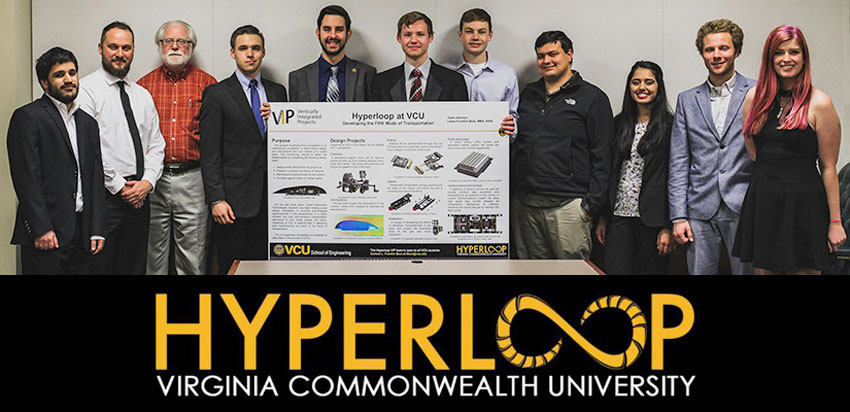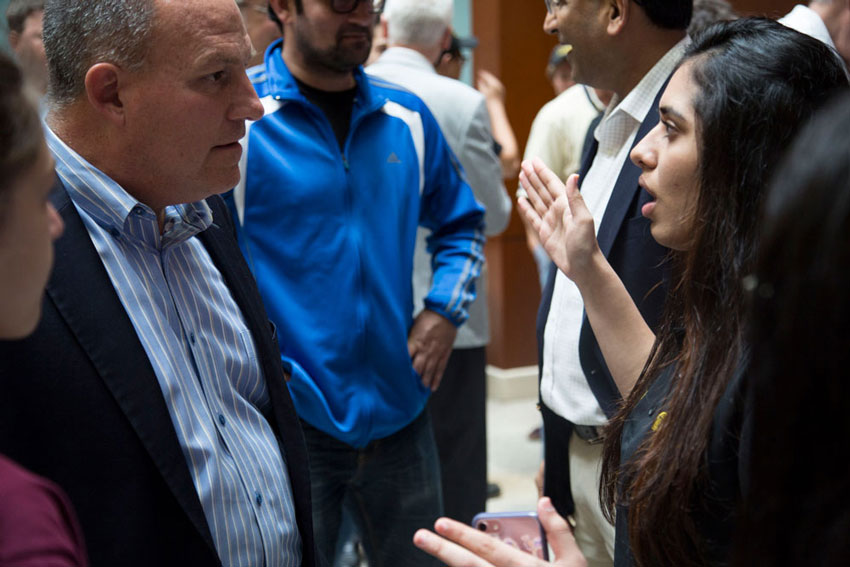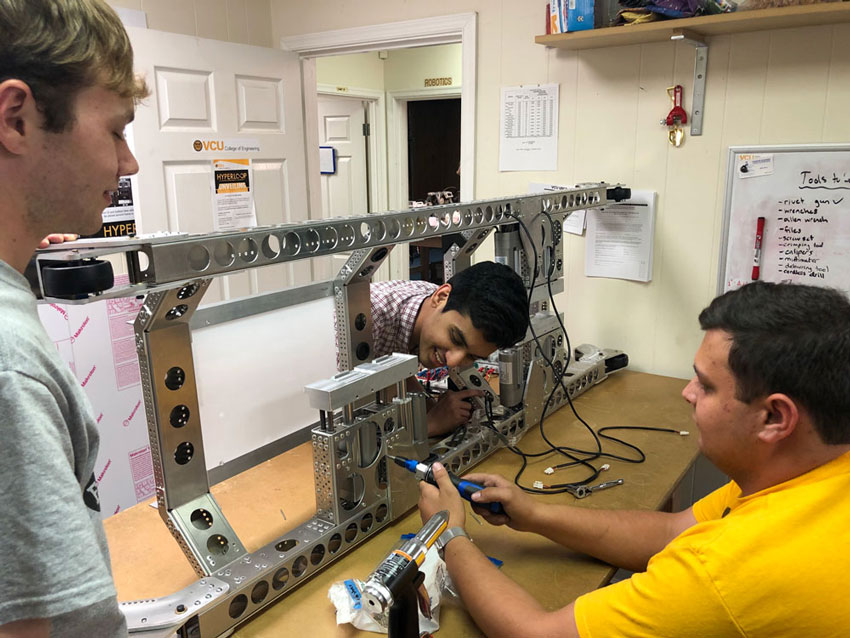By Rebecca E. Jones
At 6 p.m. on the most beautiful Saturday in June, five sleep-deprived students hunch silently around a table as a fluorescent light hums overhead. A wrench or drill occasionally cuts through the quiet. But there are few words. Like athletes or surgeons, they know the task — and each other’s rhythms — well enough to speak in the shorthand of nods, gestures and eye contact.
They have been here all day and will stay until coffee doesn’t work anymore. Would they rather be somewhere else? Not a chance. What’s a day at the beach compared with a shot at changing the world?
For the past 10 months, Hyperloop at Virginia Commonwealth University has been beating the odds and beating the clock in a dash to build the best high-speed pod vehicle to race at Elon Musk’s 2018 SpaceX Hyperloop Pod Competition in Hawthorne, California. A Hyperloop is a sealed tube free of air resistance or friction through which a pod vehicle travels at ultra-high speeds.
As SpaceX develops this proposed alternative to high-speed rail, student teams from universities worldwide compete for a slot in its annual pod competition. Hyperloop at VCU battled past challenges that eliminated hundreds of other hopefuls from around the globe. Now they are among the elites eyeing the finish line.
Last fall and winter, Hyperloop at VCU advanced through two preliminary rounds to become one of only 11 teams in the United States, and one of just 20 internationally, to earn a spot in the final round of SpaceX’s Hyperloop Competition on July 22. They’re working day and night in pursuit of maximum speed.
‘Why not make it a VCU thing?’
For most of the Hyperloop at VCU team members, the journey started Sept. 21, 2017, with an email that began:
“Do you know what the Hyperloop is? Do you want to be a part of something big and build humanity’s next form of transportation?”
It came from Arthur Chadwick, who was starting his sophomore year in the College of Engineering. Chadwick, a mechanical engineering student, was drawn to the speed and sustainability of Hyperloop, Musk’s vision of a capsule or “pod” vehicle that can shoot through near-vacuum tubes at speeds up to 700 mph and could one day be an inexpensive alternative to high-speed rail.
“I first found out about Hyperloop last summer when I was trying to figure out how I could get into engineering principles more and looking for a project,” Chadwick said. “SpaceX released their rules for the Hyperloop competition just before fall. I thought, ‘We could do this.’”
Chadwick knew it would take many different talents to make Hyperloop happen at VCU. He also knew VCU was a magnet for students who wanted to work across disciplines. One of the first people Chadwick talked to was his high school friend Harrison Powers, now a student in the VCU School of Business.
“I knew if Arthur believed this could happen, it would,” Powers said. “I also thought since Europe and Asia have bullet trains, why not us? This is going to happen anyway, so why not make it a VCU thing?”

A team of rookies
More than 50 students crowded into that first meeting in Engineering’s East Hall. One of them was Vineet Polam, who had been in college for little more than a month. The first-year mechanical engineering major was already a seasoned robotics competitor. Even so, the task of designing and building a SpaceX-worthy vehicle in less than a year sounded like a pipe dream.
“A lot of us were kind of pessimistic at that first meeting. We were saying, ‘Well, let’s do it just to learn something … we probably won’t get into SpaceX our first year … we may not even finish the pod,’” Polam said.
The group crystalized into a core of about 35 students from engineering, the arts, business and government. They formed design, mechanical, propulsion, controls, fundraising and marketing teams and started meeting three times a week, every week. Deliverables and deadlines were looming, and each was an eliminator: a preliminary design briefing followed by a design package and then a full design presentation given live via Skype. If they advanced through each of those, the actual building could start.
The harder it got, the more confident they became.
“We started researching and started to see that we could do this and decided to do it all the way,” Polam said. A member of the mechanical team, Polam sees high school robotics as something that prepared him well.
“When I looked at a complex robot, I’d think, ‘How does it do all this?’ But I found out that when you get inside it, it gets much simpler,” he said. “And it gets even simpler when you do that with a team. That has been true with Hyperloop, too.”
It also taught him how to design and build fast, and how to scrap something — such as an early magnetic brake mechanism Polam helped design that turned out to be “too risky” — without blinking.
“With the time crunch, there’s really no time to have any emotions about rejected systems,” he said. “We have to keep making stuff and moving forward with no regrets.”
Overhauling prototypes is one of the hardest parts of the design process, and one they have gotten good at. Since May, they’ve honed that skill at Build, RVA, a community makerspace in Richmond’s Scott’s Addition neighborhood. Their project and ambitions exceeded their assembly room at Build, RVA — even the window was pressed into service as a whiteboard with supply lists and lists of parts to be machined.
“We’re learning as we go because we’re all rookies. After each iteration, we do calculations and evaluations,” Polam said. “We’ve gone through four propulsion systems, three brake systems, nine shells and one frame — so far.”
Polam isn’t the youngest rookie. That title goes to high school senior Logan Schorr, who joined Hyperloop shortly after selecting VCU over the Rensselaer Polytechnic Institute. He will start his mechanical engineering degree this fall and feels Hyperloop has already armed him with insights that go beyond the classroom. “The more you build, the more you understand,” Schorr said. He likes the atmosphere at Build, RVA, which is “like a bunch of buddies working on a pod.”

‘We’re going to make them know about us.’
While others are building the pod, marketing team lead Radha Kapadia is building the brand. The role is a dream come true for the rising junior in VCU’s School of Business marketing program who has a passion for product innovation and public transit. Her interest in the latter started after a summer vacation.
“I went to Italy the summer before my senior year of high school, and it was the first time I experienced an effective public transportation system,” Kapadia said. “Then I got back to Richmond and had to drive 25 minutes to get to school. It was annoying.”
A research project at college the next year got her thinking even more about the need for green, affordable public transportation. The chance to help make it real at VCU was irresistible.
“When I saw that Hyperloop was starting at VCU, I said, ‘This is amazing!’ I had to be involved.”
The opportunity to take a deep dive into a high-tech project was also a bonus. Kapadia, a member of the VCU Innovate Living-Learning Program, has long been interested in product innovation and marketing. Crafting the message for Hyperloop at VCU has expanded her product marketing skills — and her design-and-build vocabulary. She now not only knows what it means to “cheese the holes” (put holes in a metal beam to make it lighter and reduce heat buildup), she’s watched it happen.
Kapadia said the real product she is marketing is not so much the technology as the team.
To spread the word, and bring in support, she and the team have held fundraisers in restaurants, created a professional sponsorship information packet, and doubled down on social media. “I’m posting all the time and getting the engineers to reshare. That was hard at first,” she said. “VCU may not be known for Hyperloop yet, but we are going to make them know about us.”
She is also surprised that, as they get closer to the race, the race itself becomes secondary.
“This is not about winning the competition,” Kapadia said. “It’s about the learning experience and all of us doing our best — working hard, working together.”
The optimizer
The stage between building and rebuilding is where you will likely find Colleen Foley, an electrical engineering major. A rising junior and member of the propulsion team, Foley has two scholarships that she supplements by working in VCU’s information technology support office all year. Foley has been with the team from the start, but when long work hours caused her to miss much of the machining and building, she found another niche.
“A lot of what I do is working out bugs in code, or taking what’s already been built and trying to troubleshoot it,” she said. “[Controls co-lead] John Naylor writes amazing code. [Controls co-lead] Matt Kozak builds amazing hardware. I come in toward the end as a second eye or another perspective and try to optimize it.”
Different perspectives are Foley’s specialty. Even in a university as interdisciplinary as VCU, she stands out for her wide-ranging interests. When declaring a major, she had to choose among mechanical, biomedical and electrical engineering, all of which she plans to use in her intended future career as a medical device entrepreneur. She builds and repairs watches as a hobby, dabbles in graphic design and was the go-to stage manager for plays and musicals at North Stafford High School in Stafford, Virginia.
Much of what she liked about stage managing also applies to Hyperloop.
“It gave me a chance to see the whole process instead of being just one character on stage. I like being responsible for a lot of different things. That’s definitely my role here, too. Keeping a hand in different things,” she said. “Plus, people don’t pay much attention to the techies. Those are my people, the ones you don’t necessarily see but who play a critical part.”

Hyperloop aligns perfectly with Foley’s goal to create devices that are sustainable and affordable for everyone. She sees Hyperloop as an example of cost-efficient progress that expands access to transportation.
“People who can’t afford a plane ticket will be able to use a Hyperloop,” she said. “We spend money and time building cars, and some of them get junked because they’re never bought. This is also a way to cut down on waste of products. The Hyperloop idea is much more sustainable for the ecosystem.”
Growing up as one of four children in a home where money was sometimes tight has also fed her interest in Hyperloop.
“Whenever we couldn’t get stuff we wanted, my mom would always reiterate that there are people out there who don’t have things that we get every day and don’t even realize. When I started researching access to transportation and devices, I saw how true that was.”
That, above all, is why she comes in after her job and her two summer classes to work on Hyperloop, sometimes until 1 a.m.
“I want to give back. I’ve been given so much in my life, so let me make something for people who haven’t.”

Lead from the front
Patrick Welch, a rising senior in the mechanical engineering program, came to VCU by way of community college. At 32, he’s the old man of the group, affectionately called “Dad” by his teammates. He’s also a dad in real life, with a 6-year-old son and another child on the way.
“The other day, my son asked me if I got an ‘A’ today,” Welch said. “I told him, ‘Yes, Daddy got an ‘A’ today.’”
Welch is co-lead of the mechanical team, a position he didn’t particularly want at first. “When they announced the leadership, Arthur said my name,” Welch recalled. “I said, ‘Hey, man, I never said I was going to lead a team.’”
But leading comes naturally to Welch, who was a supervisor with Walmart Distribution before pursuing a degree in engineering. He describes his leadership style as “lead from the front.” That means doing even more than the team he is leading. “If they come in at 8, you’re there at 7,” he said.
Welch is responsible for a world of mechanical logistics and deadlines, but he talks about Hyperloop almost as if it were a living thing, another member of the team.
“This pod symbolizes a lot. It embodies everything we’ve learned up to this point: statistics, electronics, thermodynamics — our whole school career. It’s like it has its own spirit. Every test, every failure is solidified there.”
Learn more about Hyperloop at VCU
- Starting July 17, check in daily with the VCU College of Engineering homepage for updates on the team’s progress in Hawthorne, California. And follow their adventures on Facebook, Twitter, Instagram and LinkedIn.
- Hear the team members tell the Hyperloop story in this video.
- Discover more about their pod vehicle and watch its official unveiling.
- Read about earlier phases of the team’s journey Blasting into the finals, Hyperloop on a mission, One of 20 teams to compete in finals and Making it to the finals.
- Go inside their Build, RVA workspace in this short video.
For Welch, the intensity of the design process, followed by months of painstaking hands-on building, made this pod something bigger than a transport prototype.
“You go through all the steps, then you make it, then you touch it. You see what your idea became,” he said. “It’s a spiritual journey. You wonder if you can do it, then it takes on a life of its own.”
He knows from experience with other groups and other projects that these last weeks before California will be among the most exciting, and most challenging.
“It’s hard seeing something through. Lots of people don’t do it,” he said. “It’s like cleaning the house and being 90 percent done. It’s hard to go that last 10 percent.”
As he and the rest of Hyperloop at VCU push through the final stage, Welch said there are no butterflies. “Right now, we’re just very focused on the schedule. When we have time to stop and think, then we’ll have butterflies. When we get to California, it will feel like a surfer on a wave.”
Until that moment, Hyperloop at VCU will be on task, fueled by the adrenaline of making something that’s never been seen before. Something beautiful and fast. Something real.
